Skopelos History, Skopelos Culture, Recent Years, Skopelos Modern Years, Ancient Years, Peparithos, Skopelos Wine, Skopelos Trade, Skopelos Agnontas, Skopelos Olympic Games, Skopelos Pirates, Skopelos Sailing Tradition, SKOPELOS NORTHERN SPORADES, GREECE, SKOPELOS BLOGSPOT, SKOPELOS BLOGGING, SKOPELOS BLOGS, SKOPELOS BLOGGERS, SKOPELOS BLOG
Skopelos through the years
SKOPELOS HISTORY
Famed for its aphrodisiac wine – ransacked by pirates – home to Olympic champions – Skopelos has a history stretching back more than eighteen centuries. Skopelos’ links with the noble grape emerged at the very dawning of the island. It was first inhabited in the Paleolithic age, according to findings on the neighbouring island of Alonissos. It was first named Peparithos, after the son of Dionysos (who is the god of wine) and Ariadne, who was the mythical first inhabitant of the island.
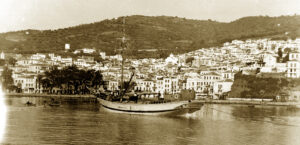
The first real remains found on Skopelos itself however date from the early and middle Mycenaean period during the 16th-14th century BC. These remains were found on the headland that separates Stafylos and Velanio beaches in the 1950s and is believed to be the tomb of the prince known as Stafylos (stafylia means grape!). This was a grave rich in treasure and artefacts and its star item is the famous golden sword of the prince which is now on display in the Archaeological Museum in Athens.
Skopelos Wine
Despite these royal beginnings, however, Skopelos didn’t t flourish until many centuries later when its famous wine became known for its aphrodisiac effects, which along with its unique flavour, were mentioned by such luminaries as Aristotle the famous philosopher! The wine, which was supposed to be aged for 7 years, was presumably also rather strong. Aristotle (albeit as a character in a play) said “three bowls do I mix for the temperate: one to health, which they empty first, the second to love and pleasure, the third to sleep. When this bowl is drunk up, wise guests go home. The fourth bowl is ours no longer, but belongs to violence; the fifth to the uproar, the sixth to drunken revel, the seventh to black eyes, the eighth is the policeman’s, the ninth belongs to biliousness, and the tenth to madness and hurling the furniture”
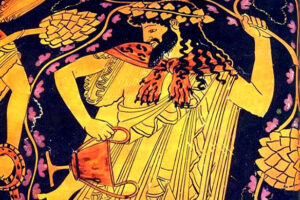
SKOPELOS Trade
The wine wasn’t the only good traded at this time, Skopelos was also renowned for its wonderful olive oil, which also was taken all around the Aegean and possibly further away. The wreck of an unusually large boat, measuring 85 x 35 ft, was found about 20 years ago off the coast of Alonissos and was believed to date from 400 BC. It had just picked up cargo from Skopelos and was carrying hundreds of jars of wine but possibly also oil.
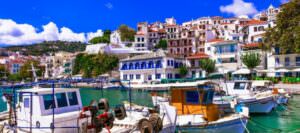
This discovery has changed the opinion of many historians who didn’t even realise that boats of such size existed in this period and it, therefore, places Skopelos as an important point in the trading routes of that time. It was also true that the island had long minted its own coinage which shows that it also had economic power.
Agnontas the Olympic champion
Sporting prowess had also brought fame to Skopelos as the long-distance runner and Olympic champion Agnondas was a Skopeliti and on his triumphal return to the island so celebrated was he (possibly in the local wine!) that they named the port he landed in after him, and it retains his name until this day when many visitors land at the sheltered harbour.
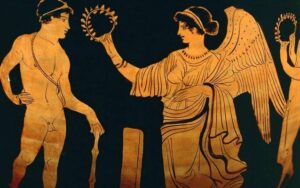
CHRISTIANITY – ST. RIGINOS
Christianity eventually reached the shores of the island in the 2nd or 3rd century AD after the Apostle Paul held sway in Athens and the Evangelist Luke preached in Thiva.
The first bishop of the island (who became a martyr and after whom many locals are named) St Riginos (Rigas) is fabled to have killed a dragon between Stafylos and Agnondas bays in about 347 AD and as he struck the final blow the land was cleaved into two, forming the deep seismic gap that is still there today where there is also a chapel with an icon of the saint and an everlasting flame.

Pirates Incursions
It seems that the golden age of Skopelos came to an end shortly afterwards, however, by the Byzantine era the incursions of pirates, who seemed to raid or use the island as a base at will, took its toll on the economy and significant building dried up. Moreover, it became used as a place of exile, a tradition which lasted many centuries, and unsurprisingly the local population dwindled in numbers leaving an island which had shrivelled from its previous wealth and position to be a lawless and distant place.
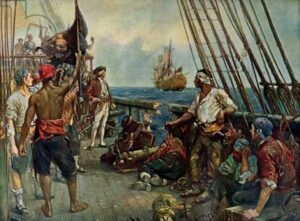
It took what was in effect a “super pirate” to change the situation. Marco Sanudo, a Venetian(also Duke of Naxos), conquered the island in 1207 just after the fall of Constantinople and used it as a base for plundering the mainland, Evvia and just about anywhere in range. Doubtless, this did not improve things greatly for the Skopelitis but at least they had some degree of stability, in fact for just short of 70 years, until the Byzantine emperor Michael Paleologos (and his admiral Alexios Filanthropinos) took the island and the now impoverished remaining islanders back.
1453 A.C
Things were bad but unbelievably they were set to get worse with the final fall of Constantinople in 1453 leading to the three islands of the Northern Sporades voting in favour of a Venetian rule (again) to avoid occupancy by the Turks. This was probably the best decision the islanders had ever made! The islands were made a separate episcopate with Skopelos, having the highest population, becoming the base but it meant that the war between the Venetians and the Turks (Ottoman Empire) swung them back and forth between the two powers.
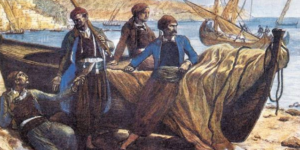
This eventually led to the biggest disaster in the history of the Sporades when the Algerian pirate Heiderin Barbarossa pulled into the harbour. Many people believe that he was asked to end the conflict by the Ottomans and did so in the most efficient way by slaughtering, or enslaving, the entire population of the three islands! Those few who survived by hiding in the mountains remained but the Turkish occupation proved, after the violent introduction, to be benign and Skopelos began the road to recovery.
The Turks never actually occupied the islands and as they repopulated with people from the mainland, Evvia and Asia Minor, the local aristocracy came to an amicable agreement with their Ottoman rulers, by providing them with a little gold and sailors for their fleet, they were given privileges and allowed to get on with rebuilding the wealth of the island.
Sailing Tradition
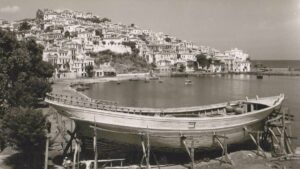
The tradition of sailing enabled the development of a large trading fleet enabling Skopelos to regain its former glory. Of course, the central position in the Aegean Sea was crucial. The rich soil and relatively good water supply also enabled the agricultural revival and olives and oil, almonds, pine resin, plums and of course wine, but not in its former quality, formed the basis of local wealth. The strength of this remarkable recovery can be seen in the fact that in the 18th century there were consuls from England, France and Venice based in Skopelos which meant that it was regarded as being a more important base than many large mainland cities which didn’t have such representation.
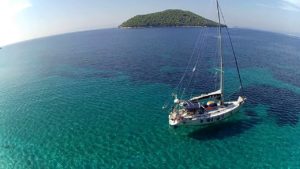
1821 A.C
This period of distance rule by the Ottomans came to an end with the outbreak of the revolution in 1821. When Skopelos actively supported the leaders of the rebellion with battleships and cargo boats. They took part in many of the battles in this conflict, which was eventually successful. Finally, in 1831 the island became officially a part of the new nation of Greece. So, Skopelos moved into the realm of modern history leaving behind its long past of tragedy and triumph.
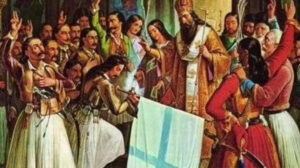
RECENT HISTORY
In the last decades, in the 1980s to be precise, the tourism industry in Skopelos started to develop. Especially after 2000 and the filming of the famous musical Mamma Mia, tourism has been on the rise.
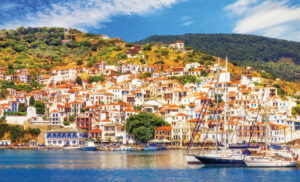
In the earlier decades of the 1950s and 60s, residents emigrated to secure a better future. Now, with the boom in tourism, Skopelos people are returning, and young people are staying on the island, taking advantage of the new conditions and opportunities provided by the development of the tourism industry.
Thus, many properties have been renovated and offered for summer accommodation, many new businesses have sprung up to attract more visitors, and modern hotel units, such as Adrina Hotels, have led tourism to a higher level.
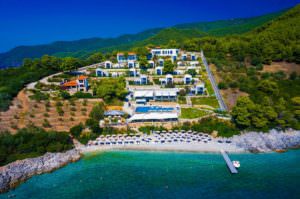
Traditional arts and cultural heritage at the same time remain thriving. Many young people are carrying on the traditions, bridging the modern with the old. Ceramics, small-scale carpentry, and knife-making are some of the traditional arts that continue to thrive.
Skopelos.com – Skopelos Blog
Blog.Skopelos.com – Skopelos.com/Blog
